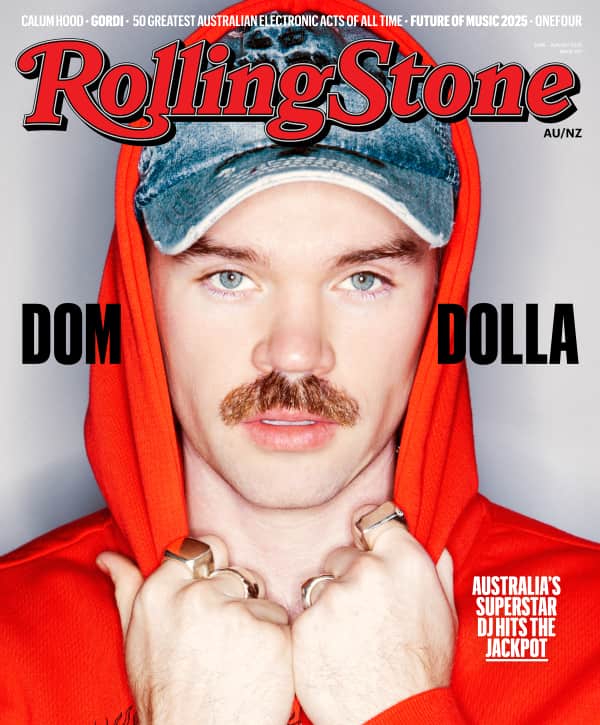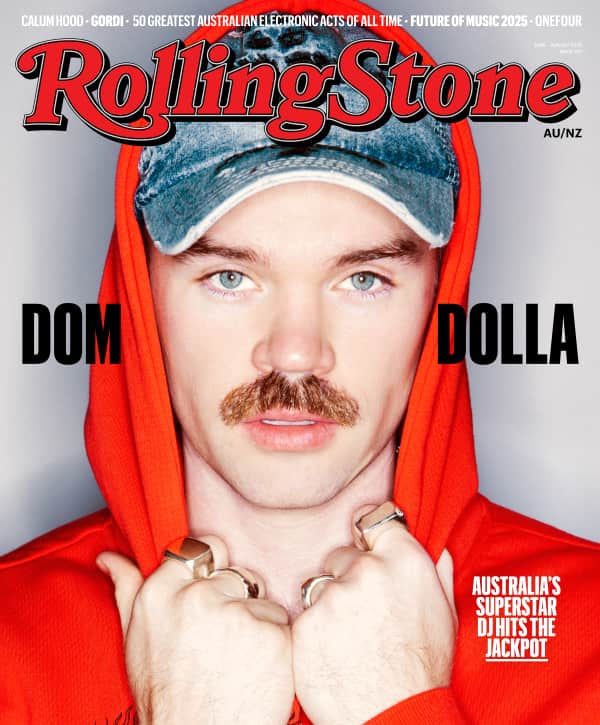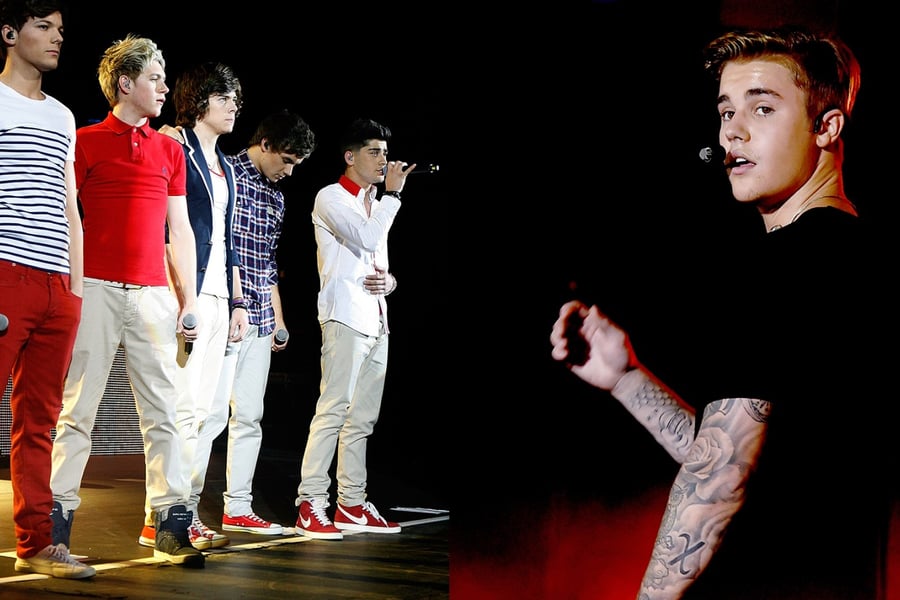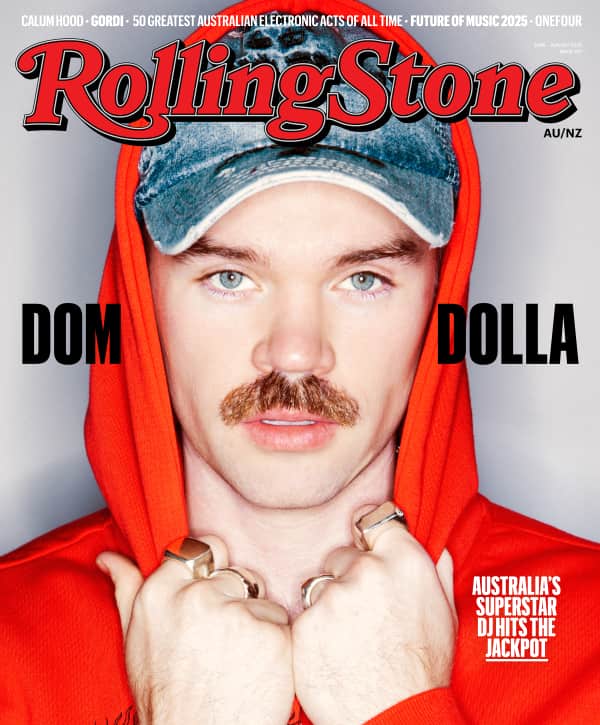The great pop battle of 2015 wasn’t really a battle at all, even Justin Bieber knew that. “It’s a friendly competition,” Bieber said in a radio interview shortly after One Direction announced that their fifth studio album, Made in the AM, would arrive on the same day as his redemptive comeback record, Purpose. “I think it was a strategy on their part, ‘cause my release date was first.” Whoever made the call to claim Nov. 13 for One Direction might have assumed that Bieber would flake.
When the boy band announced its album on Sept. 22, 2015, Purpose had only been rumored to be arriving on Friday, Nov. 13. Nothing was set in stone as far as the public knew. It didn’t even have a title yet, though Purpose ultimately rolled off the tongue better than Bieber’s Highly Anticipated Next Album. In the three years that followed 2012’s Believe, Bieber announced his retirement from the music industry, backtracked with the R&B-influenced Journals, and couldn’t seem to stop blowing up his career. In that same span of time, One Direction released three studio albums, embarked on three world tours, and found themselves down one member after Zayn Malik quit the band.
This all made it easy to frame their double release date as an intense faceoff. There were high stakes and passionate fan bases ready for battle on both sides, despite the inevitable overlap in their followings. Sometimes sides just have to be chosen. We can blame J-14 magazine printing single-page Bieber posters on the back of two-page One Direction spreads for that. When the sales were counted for Purpose and Made in the AM in their race to Number One on the Billboard Hot 100, Bieber came out ahead by 190,000 units. It couldn’t be fairly called a fight. But looking back, it’s clear that Bieber and One Direction were much closer in nonquantitative ways.
Purpose took the top slot with 649,000 album-equivalent units in its first week. Bieber’s comeback was one for the ages. The record’s lead single, “What Do You Mean?,” was a chart-topping hit, and its apologetic successor, “Sorry,” marked a career best. Bieber collaborated with Halsey, Travis Scott, and Big Sean, but also stood on his own with highlights “Company” and “Been You.” Even his motivational-speaker approach on the closing track, “All in It,” added unexpected depth to the record. “Growing up, I always felt like I had to be the best at everything,” he confesses on the outro. “‘Cause I just didn’t think I was good enough, and maybe if I was good at something that I’d get recognition from that.”
Bieber was rejuvenated, a well-oiled hitmaking machine on an era-defining streak with Purpose, even as he shouldered the weight of the past. It spent 156 weeks on the Billboard 200, was nominated for Album of the Year at the 2017 Grammy Awards, and took him on his first stadium tour. Meanwhile, One Direction were nearing the end of their second stadium tour when Made in the AM was released. They notched 49 total weeks on the chart after the album debuted at Number Two, with 459,000 album-equivalent units. It’s their only album to miss the top slot.
One Direction was just Harry Styles, Niall Horan, Liam Payne, and Louis Tomlinson by then. They’d released an album every year since 2011 like clockwork, originally with Malik as well, but this one would turn out to be their last. They never took it on the road, even after they spent all that time perfecting the art of stadium-ready pop rock. One Direction typically recorded their albums while they were on the road touring the previous one. They’d slip into nearby studios on their off days, then head back inside. The burnout eventually caught up to them.
There was something quieter and more introspective about Made in the AM, even in its most bombastic moments. “Hey Angel,” the explosive album opener, asks the question, “Do you ever cry when we waste away our lives?” They sang about flashing cameras, broken hearts, and growing apart on “Perfect,” “Infinity,” and “Walking in the Wind,” and on everything else, really. It sounded like it had finally clicked into place for them as musicians. “What a Feeling” is the truest testament to this, and even that song gives the sense they knew it wouldn’t last, asking, “Are we running out of time?”
Love Music?
Get your daily dose of everything happening in Australian/New Zealand music and globally.
One Direction’s first single as a four-piece, “Drag Me Down,” gave little indication that the end of the band would follow soon after. They confirmed their now-indefinite hiatus a month after it dropped. There was something disjointed internally. “There was periods where, literally, I’d say for five years, I didn’t leave the hotel once,” Horan said in a podcast interview last week. In 2021, Payne drew a line between this kind of life and his struggles with addiction. “The best way to secure us because of how big it got was just to lock us in our rooms,” he said at the time. “And of course, what’s in the room? Mini bar.”
The band’s schedule didn’t leave room for getting into too much trouble, at least not in view of the public. The closest they got was a leaked video of Malik and Tomlinson sharing a joint in 2014. But, mostly, trouble was Bieber terrain. That same year, the singer was arrested for drag racing and driving drunk, then charged with misdemeanor vandalism after egging his neighbor’s house. There were more controversies the year prior, and battles he faced behind closed doors. “This life can rip you apart,” Bieber told NME in 2015. “No one knew what I was feeling. I was rebelling against something deeper, and it took me a minute to realize I’m not gonna let them win.”
But at that point in their careers, Bieber and One Direction were suffering from the same effects of fame. When Purpose and Made in the AM were released, Bieber and Styles were both 21 years old. The rest of the band’s members were either 22 or 23. The piercing screams of pop stardom was all they’d known since they were teenagers. When Malik left the band, it was with the explicit goal of having the chance “to be a normal 22-year-old.” Four months later, he signed with RCA Records as a solo artist.
Could any of them have actually walked away from it all? Maybe, if that’s what they really wanted. But none of them did. In the decade that followed the Bieber’s comeback and the band’s farewell, it became evident that what they actually craved was the grace, both personally and creatively, that they weren’t afforded before. The hysteria isn’t as intense now as it was a decade ago, which seems to have been helpful in allowing them to find some version of that grace.
Bieber seems perpetually plagued by some level of it. This year, he verbally sparred with paparazzi on a few viral occasions. He also turned his Instagram Story into a diary, admitting he feels “traumatized” as well as “unequipped and unqualified most days.” And yet, he experienced a creative breakthrough on Swag, his seventh album. It’s more uninhibited and less polished than Purpose was, but charged with a sense of curiosity. “Having full creative freedom, sadly, is something new for him as an artist,” a source close to Bieber told Rolling Stone earlier this year.
Bieber wasn’t pleading for forgiveness and a return to pop’s good graces this time. As solo artists, One Direction are no longer interrogating the cost of being there. That isn’t to say there isn’t more to unpack within that, only that those conversations are mostly happening extramusically for them. “That was a tough thing for all of us, working out ‘Who am I outside of Liam in One Direction, or Louis in One Direction?’” Tomlinson recently said on the Diary of a CEO podcast. “‘Who am I and what does that look like?’ That question is really, really intimidating.”
Payne was never able to find a satisfying answer. The singer died in October 2024 following a fall from his hotel balcony. When the news broke, Bieber reposted a video of tributes that comforted fans through their grief. He added the caption, “Rest easy Liam.” No one in One Direction was more transparent about the struggles that came with being in the band — and being out of it — than Payne. He candidly discussed addiction and aired out grievances with his bandmates. He still showed up to support them. Payne attended Tomlinson’s documentary premiere and Horan’s most recent tour despite harsh backlash from fans accusing him of seeking attention by doing so.
Bieber was similarly open about his darker moments. While discussing his own experience with addiction in 2021, the singer told GQ that there was a time not too long after Purpose arrived when security guards would periodically check his pulse throughout the night to make sure he was still breathing. There’s a monumental amount of grief packed into that statement. It’s harrowing to imagine a world in which there is no comeback.
It weighs more heavily with Payne gone, and with every subsequent listen to Made in the AM. That album is about, more than anything else, saying goodbye. It’s a perfect foil to Bieber’s homecoming on Purpose. For the fans who have lived with these records for the past decade, those songs have become just as much about them as the people who created them. The same ink that wrote One Direction’s final chapter as Bieber turned the page on a new one was used to shape their own — an enduring cycle of coming and going, facing battles both internal and external.
In his last performance, hosted at a private venue in London in 2022, Payne performed a cover of the blockbuster Purpose single “Love Yourself.” Earlier that year, the singer shared that he had a chance to clear the air with Bieber a while after the great pop battle of 2015. “I said, ‘I’ve always really felt for you mate, and I think in our situation, we all suffer from the same disease,’” Payne said. “We all have this thing about us that we have to live with that’s part of our fame. I think it’s better if we all stick together.”
From Rolling Stone US



































